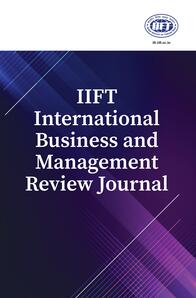
1 National Institute of Fashion Technology, NIFT Campus, Bhauri, Bhopal, Madhya Pradesh, India
Creative Commons Non Commercial CC BY-NC: This article is distributed under the terms of the Creative Commons Attribution-NonCommercial 4.0 License (http://www.creativecommons.org/licenses/by-nc/4.0/) which permits non-Commercial use, reproduction and distribution of the work without further permission provided the original work is attributed.
The research is performed keeping in view the traffic congestion in urban areas, especially metro cities in India. Getting stuck in jams for hours is a habitual matter. The peak hours are a peril. In just four metro cities in India (New Delhi, Mumbai, Kolkata and Bengaluru), traffic congestion is so high that the fuel that is burnt due to idling of vehicles at traffic jams costs around .png) 1.5 lakh crore annually ($18.75 billion). The situation is worst in the nation’s capital, New Delhi, with over $8.5 billion. Overall growth in population and economic upliftment, especially in the middle-class section, shaped an upsurge in demand for private transportation. Uber research estimates that the transport demand has increased by more than eight times since 1980 in urban India (Financial Express, 2018). According to findings by the Central Road Research Institute (CRRI) in the nation’s capital, New Delhi, every day 39,806 kg of fuel is burnt due to idling of vehicles at traffic jams (Adak, 2014). The article highlights problems faced by commuters, taking into account New Delhi as a case study. It is also largely because Delhi is affected by one of the highest vehicle densities among all the cities in the world (Adak, 2014). The assessment includes continuous observation and interview process of commuters belonging to different socio-economic classes in different areas of the city on (a) mode of transport used by them/preferred by them, (b) decision making towards the preferred mode of transport in the face of uncertainty, that is, traffic and (c) problems faced due to lack of consistent information regarding traffic. The article also discusses redefining the user interface and thereby their experience and forming an efficient and planned social system.
1.5 lakh crore annually ($18.75 billion). The situation is worst in the nation’s capital, New Delhi, with over $8.5 billion. Overall growth in population and economic upliftment, especially in the middle-class section, shaped an upsurge in demand for private transportation. Uber research estimates that the transport demand has increased by more than eight times since 1980 in urban India (Financial Express, 2018). According to findings by the Central Road Research Institute (CRRI) in the nation’s capital, New Delhi, every day 39,806 kg of fuel is burnt due to idling of vehicles at traffic jams (Adak, 2014). The article highlights problems faced by commuters, taking into account New Delhi as a case study. It is also largely because Delhi is affected by one of the highest vehicle densities among all the cities in the world (Adak, 2014). The assessment includes continuous observation and interview process of commuters belonging to different socio-economic classes in different areas of the city on (a) mode of transport used by them/preferred by them, (b) decision making towards the preferred mode of transport in the face of uncertainty, that is, traffic and (c) problems faced due to lack of consistent information regarding traffic. The article also discusses redefining the user interface and thereby their experience and forming an efficient and planned social system.
Road traffic, traffic congestion, user interface, application system
Adak, B. (2014, December 29). Delhi wastes 40 000 litres of fuel per day in traffic jams. India Today. https://www.indiatoday.in/india/story/delhi-traffic-jams-fuel-wastage-pollution-crri-report-233195-2014-12-28
Agarwal, P. (2022, October 19). Delhi Metro ridership hits 87% of pre-pandemic levels. The Times of India. https://timesofindia.indiatimes.com/city/delhi/metro-ridership-hits-87-of-pre-pandemic-levels/articleshow/94951303.cms#
ANI. (2020, May 19). Only 10% auto-rickshaw ply on roads as Delhi enters lockdown 4.0. Economic Times Auto. https://auto.economictimes.indiatimes.com/news/commercial-vehicle/lcv/only-10-auto-rickshaw-ply-on-roads-as-delhi-enters-lockdown-4-0/75817205
Capra, F., Luisi, P. L. (2014). The systems view of life a unifying vision. Cambridge University Press.
Crawford, R. P. (1954). The techniques of creative thinking. Hawthorn Books.
Delhi Development Authority. (2020). Baseline report transport. Delhi Development Authority and National Institute of Urban Affairs Collaboration. https://dda.gov.in/
Delhi Disaster Management Authority. (2014). Delhi disaster management plan. https://ddma.delhi.gov.in/
Delhi Metro. (2023). Interactive metro map. https://www.delhimetrorail.com
Financial Express. (2018, April 26). Traffic jam in 4 metros costs more than entire Rail budget; this city has worst peak-hour congestion. https://www.financialexpress.com/policy/economy-traffic-jam-in-4-metros-costs-more-than-entire-rail-budget-this-city-has-worst-peak-hour-congestion-1146356/#
Goswami, S. (2021, September 22). Delhi govt to induct only e-autos from now, one-third permits reserved for women. Hindustan Times. https://www.hindustantimes.com/cities/delhi-news/delhi-govt-to-induct-only-e-autos-from-now-one-third-permits-reserved-for-women-101632249134810.html
Goswami, S. (2022). Delhi has 13.4 million registered vehicles, but 42% of them “invalid”. Hindustan Times. https://www.hindustantimes.com/cities/delhi-news/delhi-has-13-4-million-registered-vehicles-but-42-of-them-invalid-101643672914562.html
Government of, NCT. (2023). About district. https://dmsouth.delhi.gov.in/about-district/
Jones, C. J. (1970). Design methods. John Wiley & Sons, Inc.
Khawoosa, V. M. (2019 July 28). Delhi has highest share of inter-state migrants. Hindustan Times. https://www.hindustantimes.com/delhi-news/delhi-has-highest-share-of-inter-state-migrants/story-QCYXSWlnSYAJbNb25ljcPL.html
Mani, G. (2023, February 22). How much are bike taxis used in Delhi? More than you’d think. The Indian Express. https://indianexpress.com/article/cities/delhi/how-much-are-bike-taxis-used-in-delhi-more-than-youd-think-8459198/#
Mathur, A. (2022, December 30). Sharp rise in Delhi Transport Corporation’s ridership, but losses mount due to gap in operating costs and ticket revenues. The Times of India. https://timesofindia.indiatimes.com/city/delhi/sharp-rise-in-delhi-transport-corporations-ridership-but-losses-mount-due-to-gap-in-operating-costs-ticket-revenues/articleshow/96605178.cms#
Osborn, A. F. (1963). Applied imagination. Scribner’s Sons.
Press Trust of India. (2023, July 11). India to have 1 billion smartphone users by 2026: Deloitte report. Business Standard. https://www.business-standard.com/article/current-affairs/india-to-have-1-billion-smartphone-users-by-2026-deloitte-report-122022200996_1.html
PTI. (2012, November 22). Cell phone use in Delhi increasing at an incredible rate. The Economic Times. https://economictimes.indiatimes.com/cell-phone-use-in-delhi-increasing-at-an-incredible-rate/articleshow/17323423.cmsfrom=mdr
PTI. (2023, January 2). Eighty per cent of Delhi’s bus fleet will run on electric by 2025: CM Arvind Kejriwal. The Economic Times. https://economictimes.indiatimes.com/industry/renewables/eighty-per-cent-of-delhis-bus-fleet-will-run-on-electric-by-2025-cm-arvind-kejriwal/articleshow/96677908.cmsfrom=mdr
Saini, A. (2015). Case study of cycle rickshaw on ergonomic basis. International Journal of Advanced Research in Engineering and Applied Sciences, 4(9), 55–66.
Saiyad, G., Minal Kumar, R., Dipak Rathwa, D. (2019). Trips generated by rickshaw pullers and trip rate for cycle rickshaws: A case study of Delhi. Transportation Research Procedia, 48, 2296–2312.
Sofer, C. (1972). Organizations in theory and practice. Heinemann.
The Hindu. (2018, January 20). Top 30 cities make up 51% of smartphone market; Delhi tops tally. Business Line. https://www.thehindubusinessline.com/info-tech/top-30-cities-make-up-51-of-smartphone-market-delhi-tops-tally/article64339099.ece#
World Population Review. (2023). World population by country. https://worldpopulationreview.com/